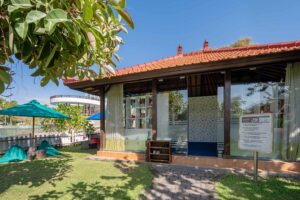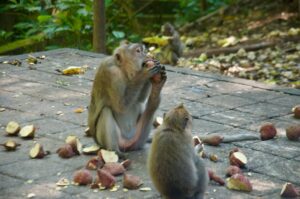Planning a surprise proposal in Bali is the start of your next great adventure. It’s a chance to create a magical moment. This moment will become a cherished story for a lifetime. The Island of the Gods offers a perfect canvas. It has breathtaking landscapes, gentle spiritual energy, and inherent romance. Use it to paint this unforgettable memory.
But where do you begin? The options are endless. You could choose a secluded beach at sunset. Or, you could go with a dramatic cliffside vista. As your friendly hosts at Merusaka Nusa Dua, we love helping to craft these moments. Here is our guide to the most romantic proposal spots. We also share the secrets to making it a perfect, stress-free surprise.
The Secret to a Perfect Proposal: A Helping Hand
The most important part of a surprise proposal is being able to relax. You want to focus on the moment. You want to be present and filled with joy. Therefore, you should not worry about the logistics. For instance, is the photographer in place? Is the champagne chilled? A little expert help comes in handy.
The Concierge team at a premier resort can be your secret partner in planning. They are local experts in romance. They can discreetly arrange every single detail for you. For example, they can secure the perfect private location. They can also coordinate photographers, flowers, and a celebratory dinner.
Bali’s Most Romantic Proposal Spots
Bali is filled with breathtaking backdrops. These are perfect for your special moment. Here are a few of our favorite ideas. We cover everything from classic beachfront romance to dramatic cliffside vistas.
1. The Secluded Beach Picnic at Sunset (Nusa Dua)
The Scene: Imagine walking hand-in-hand along a pristine white sand beach. The sun begins to set. You “stumble upon” a beautiful, secluded picnic setup just for the two of you. It comes complete with plush cushions and flickering tiki torches. A bouquet of her favorite flowers and a bottle of champagne are on ice. The gentle sound of the waves is your only soundtrack. Now, you can ask the most important question of your life.

Why it’s Perfect: This is the epitome of classic, barefoot romance. The serene shores of Mengiat Beach in Nusa Dua are ideal. They provide the perfect location for this intimate moment.
2. The Dramatic Clifftop Vista (Uluwatu)
The Scene: For a proposal with a true “wow-factor,” head to the stunning limestone cliffs of Uluwatu. The sun sinks into the Indian Ocean. It paints the sky in fiery colors. At that point, you can find a scenic viewpoint to pop the question. You will have a truly epic, panoramic backdrop.
Why it’s Perfect: This is a breathtaking, dramatic, and incredibly powerful moment. It feels like it’s on the edge of the world, just for the two of you.
3. The Intimate Private Villa
The Scene: Imagine a day of exploring. You return to your private villa. You find the space completely transformed. Floating flowers and candles fill the swimming pool. A path of petals leads to a beautifully set table for two. A private musician is playing your song.
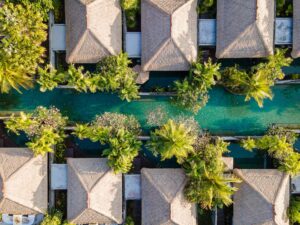
Why it’s Perfect: This offers the ultimate in privacy, comfort, and surprise. It transforms your personal sanctuary into an incredibly romantic and personal setting for your proposal.
The Finishing Touches: Making it Magical
Once you’ve chosen your spot, a few thoughtful details can elevate the moment. It goes from special to truly unforgettable. Consider arranging these things:
- A Hidden Photographer: Capture the genuine emotion of the moment secretly.
- Flowers & Decorations: Options range from a simple, beautiful bouquet to a full floral arch.
- A Celebratory Toast: Have a bottle of champagne or your favorite wine ready to pop.
- Live Music: Arrange for a solo guitarist or violinist to play “your song” at the perfect moment.
Let Us Plan Your Perfect Moment
At Merusaka Nusa Dua, we believe in creating magical memories. We help mark the start of a lifetime together. Our resort is a premier romantic wedding resort in its own right. It is the perfect place to begin your journey from “yes” to “I do.”
Our expert Concierge team specializes in planning these beautiful, secret moments. They can handle all the details discreetly. This includes securing the perfect private spot on our beach. They also arrange photographers, flowers, and a celebratory private dinner. This leaves you free to focus on the most important question you’ll ever ask.
This moment is the first page of your next chapter. Let us make it a beautiful one.

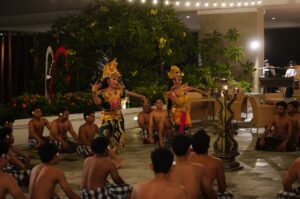 Step into a world of authentic Balinese celebration. Our BBQ Cultural Night is a vibrant, immersive experience. It brings the magic of the island’s most cherished traditions right to your table. We hold it every Thursday evening at our
Step into a world of authentic Balinese celebration. Our BBQ Cultural Night is a vibrant, immersive experience. It brings the magic of the island’s most cherished traditions right to your table. We hold it every Thursday evening at our 

 The villa experience at Merusaka is the ultimate expression of a Bali holiday. It is the
The villa experience at Merusaka is the ultimate expression of a Bali holiday. It is the 
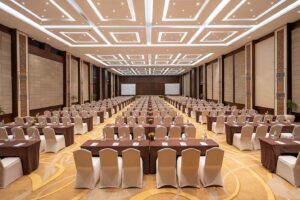 The best part of this itinerary is that we can flawlessly customize and arrange it for your group. Our dedicated team will help. When you host your event at a premier Bali conference venues like Merusaka, our MICE and Concierge teams become your partners in planning. We handle all the logistics. For example, we book spa treatments and golf tee times. We also arrange private group dinners and transportation. This leaves you free to focus on your delegates.
The best part of this itinerary is that we can flawlessly customize and arrange it for your group. Our dedicated team will help. When you host your event at a premier Bali conference venues like Merusaka, our MICE and Concierge teams become your partners in planning. We handle all the logistics. For example, we book spa treatments and golf tee times. We also arrange private group dinners and transportation. This leaves you free to focus on your delegates. 1. Amed & Jemeluk Bay (East Bali) This is a relaxed fishing village. It’s on Bali’s east coast and is a snorkeler’s paradise. The bay is very calm. You can enter the water from a beautiful black sand beach. Just a few meters from shore, you’ll find healthy coral gardens. They are teeming with colorful fish. You can even find a unique underwater “post office” sculpture.
1. Amed & Jemeluk Bay (East Bali) This is a relaxed fishing village. It’s on Bali’s east coast and is a snorkeler’s paradise. The bay is very calm. You can enter the water from a beautiful black sand beach. Just a few meters from shore, you’ll find healthy coral gardens. They are teeming with colorful fish. You can even find a unique underwater “post office” sculpture. 3. Blue Lagoon (Padang Bai) This sheltered bay is near the port town of Padang Bai. The Blue Lagoon is like a natural aquarium. The water is typically crystal clear and very calm. It has a white sandy bottom. It’s famous for its large, friendly fish. It is an incredibly rewarding spot for a first-time snorkeler.
3. Blue Lagoon (Padang Bai) This sheltered bay is near the port town of Padang Bai. The Blue Lagoon is like a natural aquarium. The water is typically crystal clear and very calm. It has a white sandy bottom. It’s famous for its large, friendly fish. It is an incredibly rewarding spot for a first-time snorkeler.

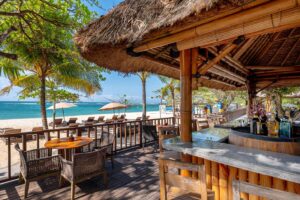 Day 1: Arrival & Pool Time! Welcome to paradise! After arriving at Merusaka, your only plan for today is to get into your swimsuits. Head straight for the pool. The kids will absolutely love our unique River Pool. They can float along the gentle current. It winds through the lush resort gardens. For dinner, keep it easy and delicious. Enjoy a casual meal of wood-fired pizzas at our beachfront
Day 1: Arrival & Pool Time! Welcome to paradise! After arriving at Merusaka, your only plan for today is to get into your swimsuits. Head straight for the pool. The kids will absolutely love our unique River Pool. They can float along the gentle current. It winds through the lush resort gardens. For dinner, keep it easy and delicious. Enjoy a casual meal of wood-fired pizzas at our beachfront 